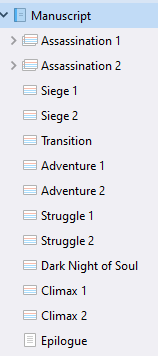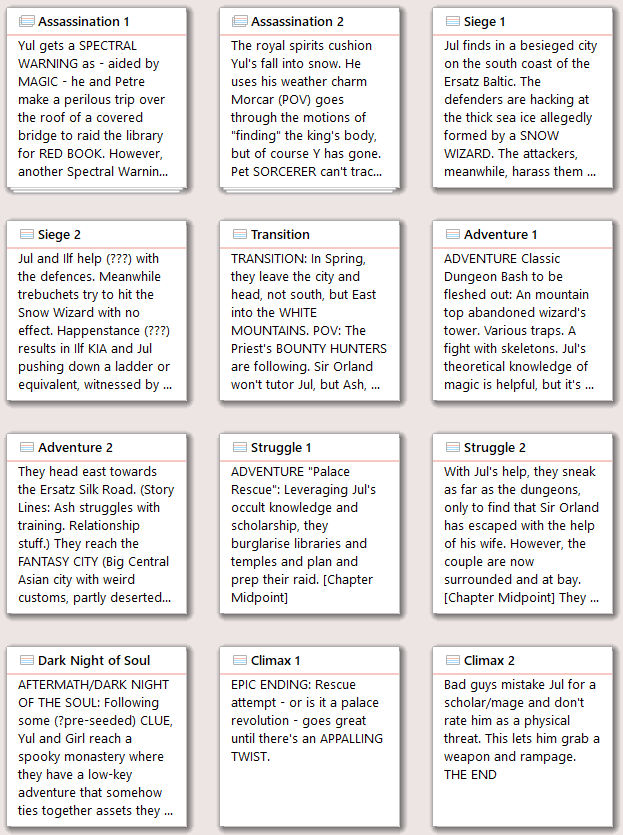Pruning Scrivener Overload
How to use Scrivener when your brain is buggered, and why Acts are bad for outlining
(First a disclaimer; I’ve been on the beach a while, so this is just me sharing how I’m going about what I do these days. Judge it on whether it’s useful to you. I claim no special credentials.
Also, I swear this Substack isn’t going to be about the process of writing, not least because aspiring writers are more interested in writing books than buying them!)
I’ve always been an outliner. Or at least, I have been an outliner for as long as I have been finishing novels.
The snag is that most outlining tools — meaning mostly Scrivener — nudge you to treat your novel like it’s a database, or a tree structure.
So you end up with organising your novel like this:
So far so organised.
Neat, even.
But that’s the problem. The novel is broken up into neat components, but at what level do you do the creativity?
Go in at Act level and you end up with very verbose text.
For example, here’s the first 33% of Act 1 of my work in progress…
Yul gets a SPECTRAL WARNING as - aided by MAGIC - he and Petre make a perilous trip over the roof of a covered bridge to raid the library for RED BOOK. However, another Spectral Warning draws his attention to an intruder in the library (who must be a royal because magic OWL).
Yul gets the red book and they retreat. However, they find themselves trapped in the royal chamber with no weapons. They prepare an ambush.
There's another warning. Their ambush takes out one assassin, but then EARL MORCAR slays Petre. Yul realises he's after the Red Book and - stealing a page - throws it in the fire as a diversion. The Earl saves the book, but more conspirators enter and capture Yul. To avoid the royal curse, they collectively throw him out of the tower window...
Yes, that’s just a third of an Act. But for me, that’s the level of detail where creating the outline is creative — I’m telling the story I would over beer in the pub... Ye Gods! But I miss the pub.
Punching all that into the synopsis for a Scrivener Act is next to useless because you then have to chop it up into Chapters and chop those Chapters into Scenes. Worse, any changes made at Scene level don’t propagate back up.
And then, if you do this with all four Acts, you end up with screeds of unbroken text that’s hard to tinker with. You might as well outline in a single document and only use Scrivener’s outlining for organising the text as you create it.
Of course, the problem with a single document is you can’t see the structure, either, but you manage…
That’s pretty much what I’ve been doing up until I got Long Covid. Now my brain is too broken for rummaging between different writing environments.
Too much depth of structure creates too much overhead. It’s just too easy to get lost in the weeds. End result is cognitive overload and mental overwhelm.
Structure doesn’t work the way “we” think it does
Recently, having spent some of my creative downtime pulling apart other people’s books, I realised that structure doesn’t quite work the way “we” think it does.
For example, in the movie - well, at least we’ve all seen it - Indiana Jones and the Raiders of the Lost Ark — the 25% mark, variously known as “Plot Point 1” and “Break Into Act 2” occurs in the middle of the Nepal episode, and the dreaded “Mid Point” is right in the middle of the Raid on the Digs episode.
So, somewhere in there you have to track episodes, roughly defined as storylines involving one context, most of which is disposed of at the end — thus keeping the story simple… which is really important if your brain is buggered, and also seems to be a feature of a lot of highly commercial sweeping fiction, which tends to keep changing the sandbox and throwing out the toys before they get boring or complicated.
My solution (Your Mileage May Vary)
So, after some tinkering, I realised you can break a novel down into 12 notional Chapters (how you divvy it up at the end is a different matter).
Just working with 12 chapters is a relief. I can see my story now.
It gets better.
How I learned to love the Scrivener Corkboard
For this project, I ignored the Outline view and did the outlining direct to Corkboard:
Here, Act Breaks are indicated by the display, they don’t exist in the file structure.
Note that most of the story is told in 2-chapter Episodes, with just two transition chapters, what I’ve labelled Transition and Dark Night of Soul.
You can change how much text is displayed by dragging the edges of the window. For example:
Three (notional) Chapters per Act seems to be the sweet spot for outlining. In this case, each represents about 6K words.
Outlining and Blocking
I’m a terse writer, so to get to 6K a (notional (remember!)) Chapter, I need roughly three Scenes or sub chapters.
So, once I’ve got a nice outline for the chapter, I plan the Scenes using just the Title field and my terse notation, “x” meaning “but” and “>” meaning “so now”:
I avoid the temptation of filling out each Scene’s Synopsis field, because my tinkering is all at Chapter level.
However, when I’m drafting, I often use the Notes field to block out the Scene itself, e.g.:
Visions of spirits x not dead
Buried in snow x uninjured
Battles free x needs a plan.
Could go up to castle x…
Each of those beat pairs is about 200 words, so you need 10 to make up a good Scene.
This sort of blocking lets you establish that there’s enough in the scene to write it, and also to identify and create any assets you need, such as room interiors or rules of magic or whatever.
Most importantly if your brain is buggered by Long Covid, the main advantage is that it makes the writing easier by establishing the pacing and solving choreography problems upfront.
How to do this at home
Make a new blank Scrivener project.
Create 12 Folders.
View them on Corkboard (with Cards Across 3, Size to fit editor).
Write and tinker.
As I said, your mileage may vary, but perhaps this will work for you the way it does for me.
I don’t really have anything new to sell off the back of this, but you can see my books on Amazon here. You can also…








